
5.1.1. Testing the capability of CMIP6 GCMs to represent precipitation variability at different temporal scales#
Production date: 31-10-2024
Produced by: CMCC foundation - Euro-Mediterranean Center on Climate Change. Albert Martinez Boti.
Most research has focused on projected long-term changes in average climates and extremes, while variability changes have received less attention. However, understanding the evolution of precipitation variability is crucial for accurately modelling climate phenomena and quantifying climate change impacts, particularly on water resources and related socioeconomic factors [1] and [2]. This notebook evaluates the capability of a subset of 16 CMIP6 Global Climate Models (GCMs) to represent precipitation variance, focusing on daily data to capture extreme precipitation events. Systematic errors are assessed by comparing model outputs against the ERA5 reanalysis, serving as the reference dataset. The analysis concentrates on the JJA (June, July, August) aggregation period but can be adapted for annual or other seasonal aggregations. Spatial patterns of average values of 2- and 3-year variances are examined for daily precipitation over the historical period from 2004 to 2014, accounting for decadal and multi-decadal timescales. Additionally, the spatially-averaged temporal evolution of the coefficient of variation (obtained by standardising the standard deviation using the mean), including trends, is analysed through 2- and 3-year moving windows and presented as time series focused on India. These insights provide valuable information on the reliability of CMIP6 models for precipitation variability analyses across different time scales.
🌍 Use case: Assessing the potential impacts of climate change on precipitation variability over India#
❓ Quality assessment question#
How well do CMIP6 projections represent historic variability of precipitation across the globe? Are there trends affecting precipitation interannual variability over India?
📢 Quality assessment statement#
These are the key outcomes of this assessment
*For the spatial patterns of average values of 2- and 3-year variances, some variation may be tied to orographic features and regions with high precipitation. This effect is removed in the time series analysis, where the coefficient of variation, which normalises the standard deviation by the mean, is considered.
*Using this approach may highlight the different orographic enhancements characterising the ensemble models, showing that some models display unique dependencies on orography for precipitation variance.
*Different mechanisms, both dynamic and thermodynamic, may be driving these patterns. For example, differences are evident between models like CMCC and BCC
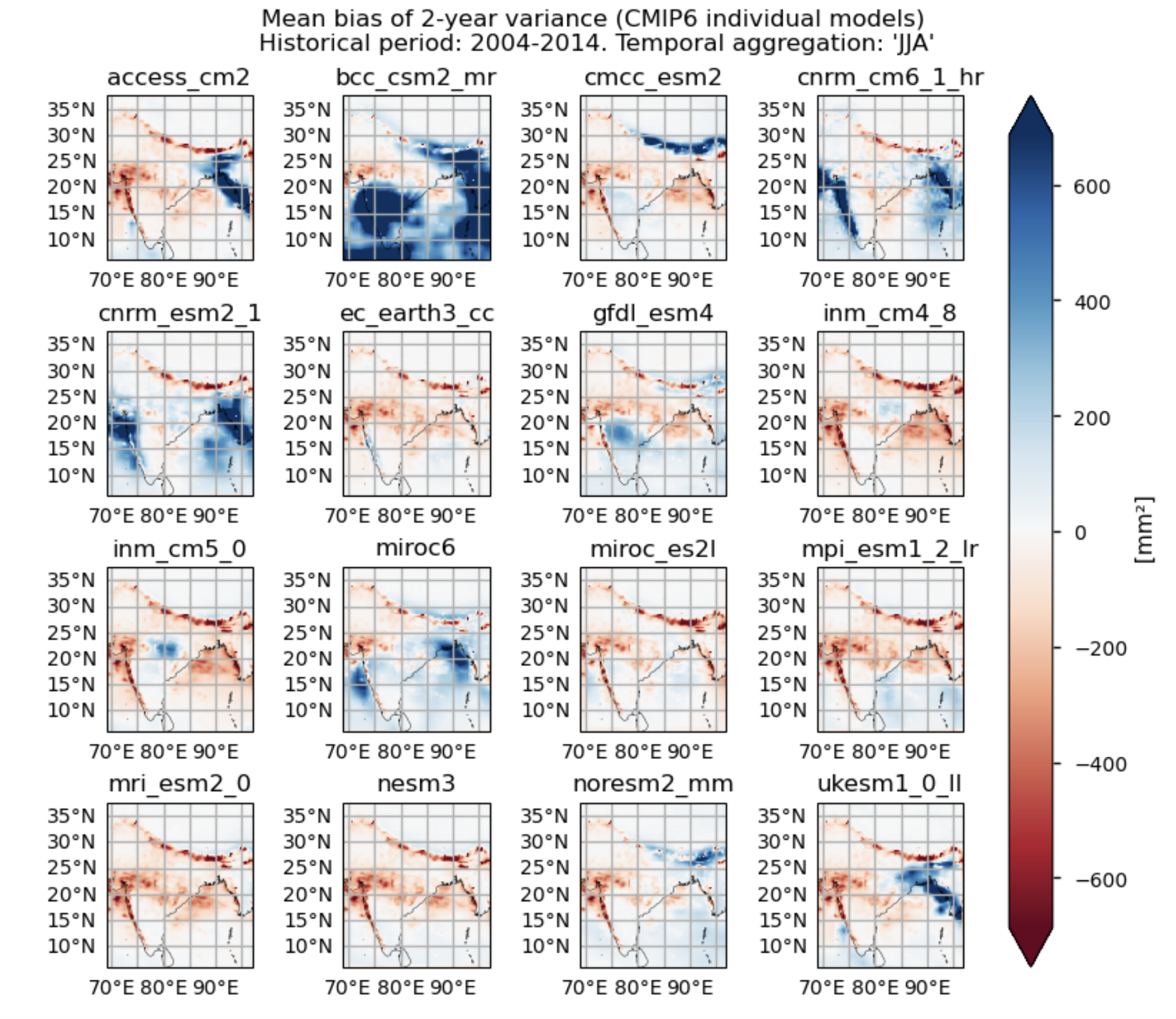
Fig. 5.1.1.1 Fig A. Mean values of 2-year variance for daily precipitation over the hisrtorical period (2004–2014) or the temporal aggregation of ‘JJA’. The layout includes data corresponding to: (a) ERA5, (b) the ensemble median (defined as the median of the mean 2-year variance values for the selected subset of models, calculated for each grid cell), (c) the bias of the ensemble median, and (d) the ensemble spread (calculated as the standard deviation of the 2-year variance for the selected subset of models).#
In this notebook, we focus on seasonal aggregations to prevent overload. It's important to note that using seasonal temporal aggregations offers only partial insights into the dynamics. For more comprehensive results, it's advisable to also consider other seasons and annual aggregations. However, for the sake of efficiency and to avoid making the notebook too heavy, we have opted to prioritise seasonal aggregations.
📋 Methodology#
This notebook provides an assessment of systematic errors in representing precipitation variability for a subset of 16 models from the CMIP6 project, focusing on the JJA aggregation (the rainy season in India), though other seasonal or annual aggregations can be configured. Variances have been calculated to represent the variability (similar to [3] and [4]). To also characterise the variability associated with extreme precipitation, daily temporal resolution is used.
The analysis examines spatial patterns of average values of 2- and 3-year variances (to account for decadal and multi-decadal timescales) for daily precipitation over the period 2004–2014, and calculates biases for each model and the ensemble median (per grid cell). Additionally, spatially-averaged temporal evolution of the coefficient of variation (obtained by standardising the standard deviation using the mean), including trends, is analysed through 2- and 3-year moving windows and presented as time series focused on India, following a methodology similar to [5].
The analysis and results follow the next outline:
1. Parameters, requests and functions definition
📈 Analysis and results#
1. Parameters, requests and functions definition#
1.1. Import packages#
Show code cell source
import math
import tempfile
import warnings
import textwrap
warnings.filterwarnings("ignore")
import cartopy.crs as ccrs
import numpy as np
import matplotlib.pyplot as plt
import xarray as xr
import pandas as pd
from c3s_eqc_automatic_quality_control import diagnostics, download, plot, utils
import matplotlib.dates as mdates
from xarrayMannKendall import Mann_Kendall_test
from scipy.stats import linregress
1.2. Define Parameters#
In the “Define Parameters” section, various customisable options for the notebook are specified:
The initial and ending year used for the historical period can be specified by changing the parameters
year_startandyear_stop(2004-2014 is chosen).The
timeseriesset the temporal aggregation. For instance, selecting “JJA” implies considering only the JJA season. “Annual” has been selected for this notebook.areaallows specifying the geographical domain of interest when assessing the temporal evolution of the variability. A domain including the Indian Peninsula has been selected.The
interpolation_methodparameter allows selecting the interpolation method when regridding is performed.The
chunkselection allows the user to define if dividing into chunks when downloading the data on their local machine. Although it does not significantly affect the analysis, it is recommended to keep the default value for optimal performance.variance_valuesdefines the temporal width (in years) over which the variance is calculated.variableandcollection_idare not customisable for this assessment and are set to ‘precipitation’ and ‘CMIP6’. Expert users can use this notebook as a guide to create similar analyses for other variables or model sets (such as CORDEX).
Show code cell source
# Time period
year_start = 2004
year_stop = 2014
assert year_start >= 1940
# Choose annual or seasonal timeseries
timeseries = "JJA"
assert timeseries in ("annual", "DJF", "MAM", "JJA", "SON")
# Interpolation method
interpolation_method = "conservative"
# Area to show
area = [38, 68, 5, 98]
# Chunks for download
chunks = {"year": 1}
#Variances temporal agg
variance_values=[2,3]
# Variable
variable = "precipitation"
assert variable in ("precipitation")
#Collection id
collection_id = "CMIP6"
assert collection_id in ("CMIP6")
1.3. Define models#
The following climate analyses are performed considering a subset of GCMs from CMIP6.
The selected CMIP6 models have available both the historical and SSP5-8.5 experiments.
Show code cell source
match variable:
case "precipitation":
resample_reduction = "sum"
era5_variable = "total_precipitation"
era5_variable_short = "tp"
cmip6_variable = "precipitation"
cmip6_variable_short="pr"
models_cmip6 = (
"access_cm2",
"bcc_csm2_mr",
"cmcc_esm2",
"cnrm_cm6_1_hr",
"cnrm_esm2_1",
"ec_earth3_cc",
"gfdl_esm4",
"inm_cm4_8",
"inm_cm5_0",
"mpi_esm1_2_lr",
"miroc6",
"miroc_es2l",
"mri_esm2_0",
"noresm2_mm",
"nesm3",
"ukesm1_0_ll",
)
cbars = {"cmap_divergent": "RdBu", "cmap_sequential": "viridis_r"}
case _:
raise NotImplementedError(f"{variable=}")
1.4. Define ERA5 request#
Within this notebook, ERA5 serves as the reference product. In this section, we set the required parameters for the cds-api data-request of ERA5.
Show code cell source
request_era = (
"reanalysis-era5-single-levels",
{
"product_type": "reanalysis",
"data_format": "netcdf",
"time": [f"{hour:02d}:00" for hour in range(24)],
"variable": era5_variable,
"year": [
str(year)
for year in range(year_start - int(timeseries == "DJF"), year_stop + 1)
], # Include D(year-1)
"month": [f"{month:02d}" for month in range(1, 13)],
"day": [f"{day:02d}" for day in range(1, 32)],
"area":area,
},
)
request_lsm = (
request_era[0],
request_era[1]
| {
"year": "1940",
"month": "01",
"day": "01",
"time": "00:00",
"variable": "land_sea_mask",
},
)
1.5. Define model requests#
In this section we set the required parameters for the cds-api data-request.
Show code cell source
request_cmip6 = {
"format": "zip",
"temporal_resolution": "daily",
"experiment": "historical",
"variable": cmip6_variable,
"year": [
str(year) for year in range(year_start, year_stop + 1)
], # Include D(year-1)
"month": [f"{month:02d}" for month in range(1, 13)],
"day": [f"{day:02d}" for day in range(1, 32)],
"area": area,
}
model_requests = {}
if collection_id == "CMIP6":
for model in models_cmip6:
model_requests[model] = (
"projections-cmip6",
download.split_request(request_cmip6 | {"model": model}, chunks=chunks),
)
else:
raise ValueError(f"{collection_id=}")
1.6. Functions to cache#
In this section, functions that will be executed in the caching phase are defined. Caching is the process of storing copies of files in a temporary storage location, so that they can be accessed more quickly. This process also checks if the user has already downloaded a file, avoiding redundant downloads.
Functions description:
get_grid_outandadd_boundsensure the regrid is performed properly.The
select_timeseriesfunction subsets the dataset based on the chosentimeseriesparameter.The
compute_rolling_variancecalculates the rolling variance.The
compute_variancefunction selects the temporal aggregation using theselect_timeseriesfunction. It then computes the rolling variance over the historical period (2004–2014) by callingcompute_rolling_variance. The window widths are 2 and 3 years, with a step size of one year.
Show code cell source
def select_timeseries(ds, timeseries, year_start, year_stop):
if timeseries == "annual":
return ds.sel(time=slice(str(year_start), str(year_stop)))
return ds.where(ds["time"].dt.season == timeseries, drop=True)
def compute_rolling_variance(ds, window_years, timeseries, resample_reduction=None):
# Get the total number of days per year or season
days_per_year = 360 if timeseries == "annual" else 90
# Total days in the rolling window
days_in_window = int(days_per_year * window_years)
## Apply rolling variance over the calculated window size and calculate the coefficient of variation
rolling_var = ds.rolling(time=days_in_window, min_periods=days_in_window, center=False).var()
rolling_mean= ds.rolling(time=days_in_window, min_periods=days_in_window, center=False).mean()
rolling_CV=(rolling_var**(1/2))/rolling_mean
rolling_var = rolling_var.groupby("time.year").last()
rolling_CV = rolling_CV.groupby("time.year").last()
time_last_per_year = ds["time"].groupby("time.year").last().data
# Reassign the correct time coordinates to the rolling variance dataset
rolling_var["year"]=time_last_per_year
rolling_CV["year"]=time_last_per_year
rolling_var=rolling_var.rename({"year":"time"})
rolling_CV=rolling_CV.rename({"year":"time"})
rolling_var=rolling_var.convert_calendar('proleptic_gregorian', align_on='date', use_cftime=False)
rolling_CV=rolling_CV.convert_calendar('proleptic_gregorian', align_on='date', use_cftime=False)
#Units change
rolling_var *= (1000 ** 2) if resample_reduction else (86400 ** 2)
# Apply the adjust_day function to the time coordinate
rolling_var["time"] = rolling_var["time"].dt.floor('D')
rolling_CV["time"]=rolling_CV["time"].dt.floor('D')
return rolling_var,rolling_CV
def add_bounds(ds):
for coord in {"latitude", "longitude"} - set(ds.cf.bounds):
ds = ds.cf.add_bounds(coord)
return ds
def get_grid_out(request_grid_out, method):
ds_regrid = download.download_and_transform(*request_grid_out)
coords = ["latitude", "longitude"]
if method == "conservative":
ds_regrid = add_bounds(ds_regrid)
for coord in list(coords):
coords.extend(ds_regrid.cf.bounds[coord])
grid_out = ds_regrid[coords]
coords_to_drop = set(grid_out.coords) - set(coords) - set(grid_out.dims)
return grid_out.reset_coords(coords_to_drop, drop=True)
def compute_variance(
ds, timeseries, year_start, year_stop, variance_values,
resample_reduction=None, request_grid_out=None, **regrid_kwargs
):
# Apply resample reduction if specified
if resample_reduction:
resampled = ds.resample(time="1D")
ds = getattr(resampled, resample_reduction)(keep_attrs=True)
# Select the time series
ds = select_timeseries(ds, timeseries, year_start, year_stop)
ds = ds.convert_calendar('360_day', align_on='year', use_cftime=True)
# Prepare lists for storing rolling variances and coefficients of variance
rolling_variances, rolling_coefficients_of_variance = [], []
# Loop through variance values to compute rolling variances and coefficients
for variance in variance_values:
rolling_var, rolling_CV = compute_rolling_variance(ds, window_years=variance,
timeseries=timeseries,
resample_reduction=resample_reduction)
rolling_variances.append(rolling_var.expand_dims(variance=[f"rolling variance {variance}"]))
rolling_coefficients_of_variance.append(rolling_CV.expand_dims(variance=[f"rolling variance {variance}"]))
# Concatenate and merge into a single dataset with both dimensions
ds_variances = xr.concat(rolling_variances, dim="variance", coords="minimal", compat="override")
ds_coefficients = xr.concat(rolling_coefficients_of_variance, dim="variance", coords="minimal", compat="override")
ds_coefficients = ds_coefficients.rename({list(ds_coefficients.data_vars)[0]: "coefficient_of_variation"})
ds = xr.merge([ds_variances, ds_coefficients], compat="override")
# Handle grid output if requested
if request_grid_out:
grid_out = get_grid_out(request_grid_out, method="bilinear")# regrid_kwargs["method"])
ds = diagnostics.regrid(ds, grid_out=grid_out, method="bilinear")#**regrid_kwargs)
return ds
2. Downloading and processing#
2.1. Download and transform ERA5#
In this section, the download.download_and_transform function from the ‘c3s_eqc_automatic_quality_control’ package is used to download ERA5 reference data, select the temporal aggregation (“JJA” in this example), compute 2- and 3-year rolling variances from daily data for the historical period (2004-2015), and cache the result to avoid redundant downloads and processing.
Show code cell source
transform_func_kwargs = {
"timeseries": timeseries,
"year_start": year_start,
"year_stop": year_stop,
"variance_values":variance_values,
}
ds_era5 = download.download_and_transform(
*request_era,
chunks=chunks,
transform_chunks=False,
transform_func=compute_variance,
transform_func_kwargs=transform_func_kwargs
| {"resample_reduction": resample_reduction},
)
2.2. Download and transform models#
In this section, the download.download_and_transform function from the ‘c3s_eqc_automatic_quality_control’ package is employed to download daily data from the CMIP6 models, select the temporal aggregation (“JJA” in this example), compute 2- and 3-year rolling variances from daily data for the historical period (2004-2015), interpolate to ERA5’s grid (only for the cases in which it is specified, in the other cases, the original model’s grid is mantained), and cache the result (to avoid redundant downloads and processing).
Show code cell source
interpolated_datasets = []
model_datasets = {}
for model, requests in model_requests.items():
print(f"{model=}")
model_kwargs = {
"chunks": chunks if collection_id == "CMIP6" else None,
"transform_chunks": False,
"transform_func": compute_variance,
}
# Original model
model_datasets[model] = download.download_and_transform(
*requests,
**model_kwargs,
transform_func_kwargs=transform_func_kwargs,
)
# Interpolated model
ds = download.download_and_transform(
*requests,
**model_kwargs,
transform_func_kwargs=transform_func_kwargs
| {
"request_grid_out": request_lsm,
"method": interpolation_method,
"skipna": True,
},
)
interpolated_datasets.append(ds.expand_dims(model=[model]))
ds_interpolated = xr.concat(interpolated_datasets, "model",coords='minimal', compat='override')
model='access_cm2'
model='bcc_csm2_mr'
model='cmcc_esm2'
model='cnrm_cm6_1_hr'
model='cnrm_esm2_1'
model='ec_earth3_cc'
model='gfdl_esm4'
model='inm_cm4_8'
model='inm_cm5_0'
model='mpi_esm1_2_lr'
model='miroc6'
model='miroc_es2l'
model='mri_esm2_0'
model='noresm2_mm'
model='nesm3'
model='ukesm1_0_ll'
2.3. Change some attributes#
Show code cell source
# Drop 'bnds' dimension if it exists for each dataset and for the interpolated dataset
model_datasets = {model: ds.drop_dims('bnds') if 'bnds' in ds.dims else ds
for model, ds in model_datasets.items()}
ds_interpolated=ds_interpolated.drop("bnds")
ds_era5=ds_era5.rename({era5_variable_short:cmip6_variable_short})
for ds in (ds_era5, ds_interpolated, *model_datasets.values()):
ds[cmip6_variable_short].attrs = {"long_name": "", "units": "mm²"}
3. Plot and describe results#
This section will display the following results:
Maps showing the spatial distribution of the mean values of 2-year variances for daily precipitation over the period 2004–2014, including ERA5, individual models, the ensemble median (defined as the median of the mean 2-year variance values for the selected subset of models, calculated for each grid cell) and its bias, and the ensemble spread (derived as the standard deviation of the 2-year variance for the selected subset of models).
Maps showing the spatial distribution of the mean values of 3-year variances for daily precipitation over the period 2004–2014, including ERA5, individual models, the ensemble median (defined as the median of the mean 3-year variance values for the selected subset of models, calculated for each grid cell) and its bias, and the ensemble spread (derived as the standard deviation of the 2-year variance for the selected subset of models).
Bias maps of the temporal mean values of the 2- and 3-year variances for each model.
Timeseries showing the evolution of the 2-year and 3-year coefficient of variation over the historical period, including trends and inter-model spread.
3.1. Define plotting functions#
The functions presented here are used to plot the mean values of 2- and 3-year variances for daily precipitation over the period 2004–2014
Three layout types can be displayed, depending on the chosen function:
Layout including the reference ERA5 product, the ensemble median, the bias of the ensemble median, and the ensemble spread:
plot_ensemble()is used.Layout including every model:
plot_models()is employed.Layout including the bias of every model:
plot_models()is used again.
Show code cell source
#Define function to plot the caption of the figures (for the ensmble case)
def add_caption_ensemble(window,exp):
#Add caption to the figure
caption_text= (
f"Fig {fig_number}. Mean values of {window}-year variance for "
f"daily precipitation over the {exp} period ({year_start}–{year_stop}) "
f"for the temporal aggregation of '{timeseries}'. "
f"The layout includes data corresponding to: (a) ERA5, (b) the ensemble median "
f"(defined as the median of the mean {window}-year variance values for the selected "
f"subset of models, calculated for each grid cell), "
f"(c) the bias of the ensemble median, and (d) the ensemble spread "
f"(calculated as the standard deviation of the {window}-year variance "
f"for the selected subset of models)."
)
wrapped_lines = textwrap.wrap(caption_text, width=105)
# Add each line to the figure
for i, line in enumerate(wrapped_lines):
fig.text(0.05, -0.05 - i * 0.03, line, ha='left', fontsize=10)
#end captioning
#Define function to plot the caption of the figures (for the individual models case)
def add_caption_models(bias,exp,window):
#Add caption to the figure
if bias:
caption_text = (
f"Fig {fig_number}. Mean bias of the {window}-year variance for daily "
f"precipitation over the {exp} period ({year_start}–{year_stop}) for "
f"the temporal aggregation of '{timeseries}'.The layout displays each "
f"individual {collection_id} model."
)
else:
caption_text = (
f"Fig {fig_number}. Mean values of the {window}-year variance for daily "
f"precipitation over the {exp} period ({year_start}–{year_stop}) for the "
f"temporal aggregation of '{timeseries}'. The layout displays each individual "
f"{collection_id} model."
)
wrapped_lines = textwrap.wrap(caption_text, width=110)
# Add each line to the figure
for i, line in enumerate(wrapped_lines):
fig.text(0, -0.05 - i * 0.03, line, ha='left', fontsize=10)
def set_extent(da, axs, area):
extent = [area[i] for i in (1, 3, 2, 0)]
for i, coord in enumerate(extent):
extent[i] += -1 if i % 2 else +1
for ax in axs:
ax.set_extent(extent)
def plot_models(
data,
da_for_kwargs=None,
col_wrap=4,
subplot_kw={"projection": ccrs.PlateCarree()},
figsize=None,
layout="constrained",
area=area,
flip_cmaps=False,
**kwargs,
):
if isinstance(data, dict):
assert da_for_kwargs is not None
model_dataarrays = data
else:
da_for_kwargs = da_for_kwargs or data
model_dataarrays = dict(data.groupby("model"))
# Get kwargs
default_kwargs = {"robust": True, "extend": "both"}
kwargs = default_kwargs | kwargs
kwargs = xr.plot.utils._determine_cmap_params(da_for_kwargs.values, **kwargs)
fig, axs = plt.subplots(
*(col_wrap, math.ceil(len(model_dataarrays) / col_wrap)),
subplot_kw=subplot_kw,
figsize=figsize,
layout=layout,
)
axs = axs.flatten()
for (model, da), ax in zip(model_dataarrays.items(), axs):
pcm = plot.projected_map(
da, ax=ax, show_stats=False, add_colorbar=False, **kwargs
)
ax.set_title(model)
set_extent(da_for_kwargs, axs, area)
fig.colorbar(
pcm,
ax=axs.flatten(),
extend=kwargs["extend"],
location="right",
label=f"{da_for_kwargs.attrs.get('long_name', '')} [{da_for_kwargs.attrs.get('units', '')}]",
)
return fig
def plot_ensemble(
da_models,
da_era5=None,
subplot_kw={"projection": ccrs.PlateCarree()},
figsize=None,
layout="constrained",
cbar_kwargs=None,
area=area,
flip_cmaps=False,
**kwargs,
):
# Get kwargs
default_kwargs = {"robust": True, "extend": "both"}
kwargs = default_kwargs | kwargs
kwargs = xr.plot.utils._determine_cmap_params(
da_models.values if da_era5 is None else da_era5.values, **kwargs
)
if da_era5 is None and cbar_kwargs is None:
cbar_kwargs = {"orientation": "horizontal"}
# Figure
fig, axs = plt.subplots(
*(1 if da_era5 is None else 2, 2),
subplot_kw=subplot_kw,
figsize=figsize,
layout=layout,
)
axs = axs.flatten()
axs_iter = iter(axs)
# ERA5
if da_era5 is not None:
ax = next(axs_iter)
plot.projected_map(
da_era5, ax=ax, show_stats=False, cbar_kwargs=cbar_kwargs, **kwargs
)
ax.set_title("(a) ERA5")
# Median
ax = next(axs_iter)
median = da_models.median("model", keep_attrs=True)
plot.projected_map(
median, ax=ax, show_stats=False, cbar_kwargs=cbar_kwargs, **kwargs
)
ax.set_title("(b) Ensemble Median" if da_era5 is not None else "(a) Ensemble Median")
# Bias
if da_era5 is not None:
ax = next(axs_iter)
with xr.set_options(keep_attrs=True):
bias = median - da_era5
plot.projected_map(
bias,
ax=ax,
show_stats=False,
center=0,
cbar_kwargs=cbar_kwargs,
**default_kwargs,
)
ax.set_title("(c) Ensemble Median Bias")
# Std
ax = next(axs_iter)
std = da_models.std("model", keep_attrs=True)
plot.projected_map(
std, ax=ax, show_stats=False, cbar_kwargs=cbar_kwargs, **default_kwargs
)
ax.set_title("(d) Ensemble Standard Deviation" if da_era5 is not None else "(b) Ensemble Standard Deviation")
set_extent(da_models, axs, area)
return fig
3.2. Plot ensemble maps#
In this section, we invoke the plot_ensemble() function to visualise the mean values of 2- and 3-year variances for daily precipitation over the period 2004–2014 for: (a) the reference ERA5 product, (b) the ensemble median (defined as the median of the mean 2- and 3-year variance values for the selected subset of models, calculated for each grid cell), (c) the bias of the ensemble median, and (d) the ensemble spread (calculated as the standard deviation of the 2- and 3-year variance for the selected subset of models).
Show code cell source
#Change default colorbars
xr.set_options(**cbars)
#Fig number counter
fig_number=1
#Common title
common_title = f"Historical period: {year_start}-{year_stop}. Temporal aggregation: '{timeseries}'"
for window in range(0,2):
#Select the mean values of the variances
da = ds_interpolated.mean(dim="time",keep_attrs=True).isel(variance=window)[cmip6_variable_short]
da_era5=ds_era5.mean(dim="time",keep_attrs=True).isel(variance=window)[cmip6_variable_short]
#Call the function
fig = plot_ensemble(da_models=da, da_era5=da_era5,figsize=[7.5,6])
fig.suptitle(f"Mean of {variance_values[window]}-year variance (ERA5 vs {collection_id} ensemble)\n {common_title}")
add_caption_ensemble(window=variance_values[window],exp="historical")
plt.show()
fig_number=fig_number+1
print(f"\n")
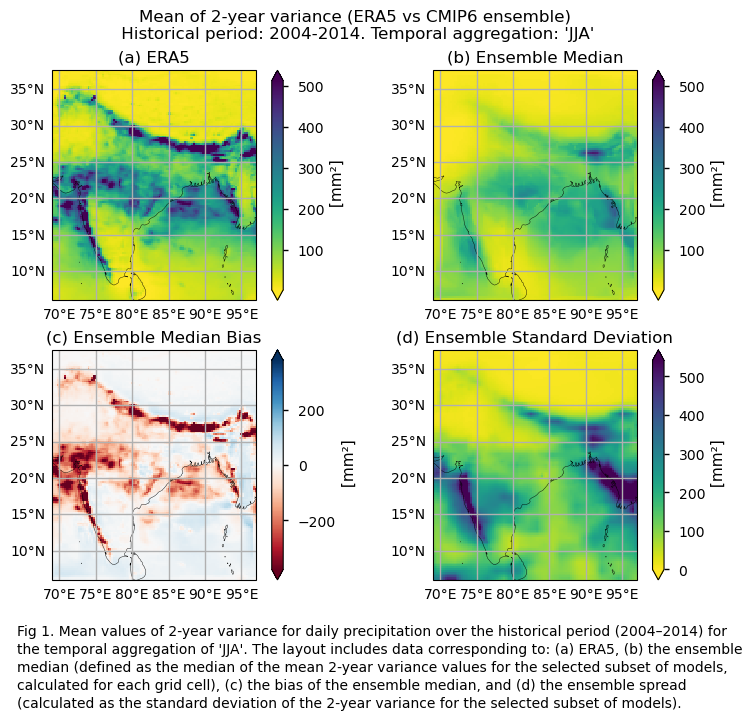
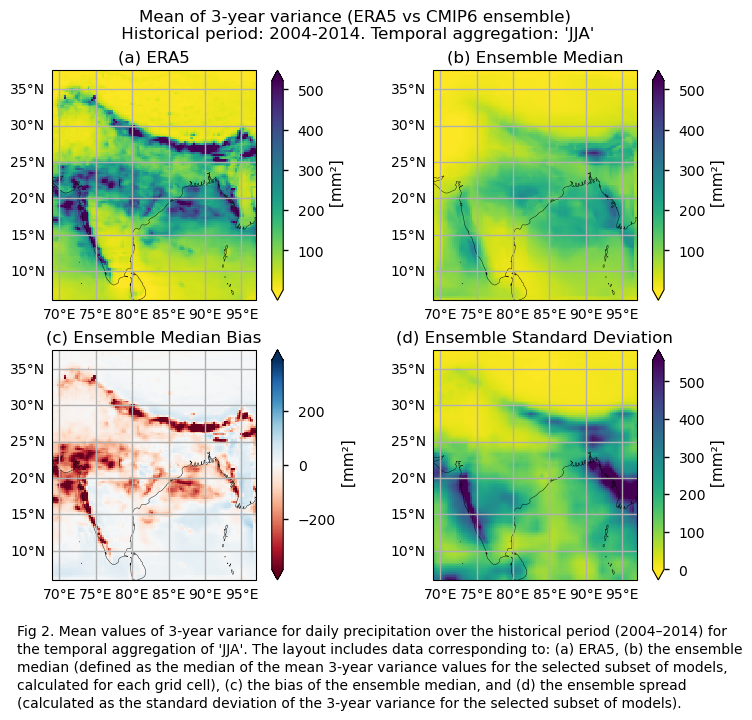
3.3. Plot model maps#
In this section, we invoke the plot_models() function to visualise the mean values of 2- and 3-year variances for daily precipitation over the period 2004–2014 for every model individually. Note that the model data used in this section maintains its original grid.
Show code cell source
for window in range(0,2):
da_for_kwargs = ds_era5.mean(dim="time",keep_attrs=True).isel(variance=window)[cmip6_variable_short]
fig = plot_models(
data={model: ds.mean(dim="time").isel(variance=window)[cmip6_variable_short] for model, ds in model_datasets.items()},
da_for_kwargs=da_for_kwargs,
figsize=[8,7],
)
fig.suptitle(f"Mean of {variance_values[window]}-year variance ({collection_id} individual models)\n {common_title}")
add_caption_models(window=variance_values[window],bias=False,exp="historical")
plt.show()
print(f"\n")
fig_number=fig_number+1
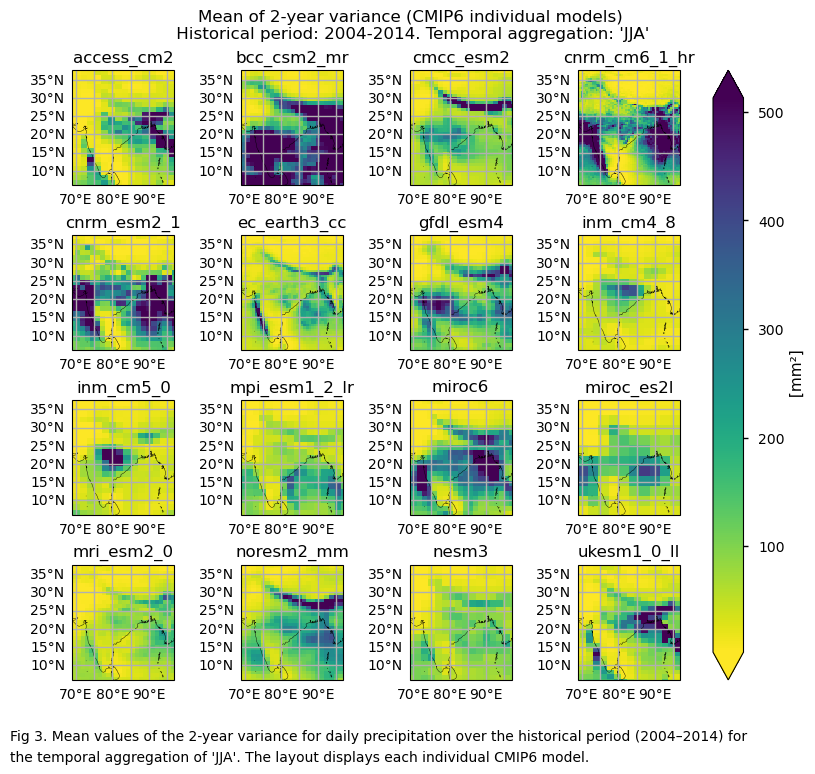
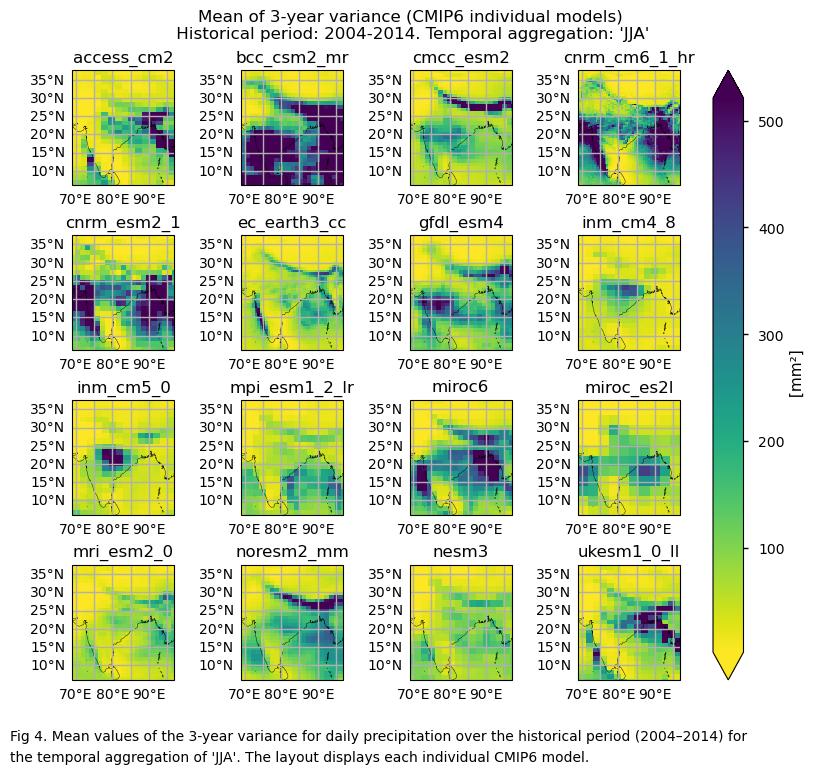
3.4. Plot bias maps#
In this section, we invoke the plot_models() function to visualise the bias for the mean values of 2- and 3-year variances for daily precipitation over the period 2004–2014 for every model individually. Note that the model data used in this section has previously been interpolated to the ERA5 grid.
Show code cell source
for window in range (0,2):
with xr.set_options(keep_attrs=True):
bias = ds_interpolated.mean(dim="time").isel(variance=window) - ds_era5.mean(dim="time").isel(variance=window)
da = bias[cmip6_variable_short]
fig = plot_models(data=da, center=0,figsize=[8,7])
fig.suptitle(f"Mean bias of {variance_values[window]}-year variance ({collection_id} individual models)\n {common_title}")
add_caption_models(window=variance_values[window],bias=True,exp="historical")
plt.show()
print(f"\n")
fig_number=fig_number+1
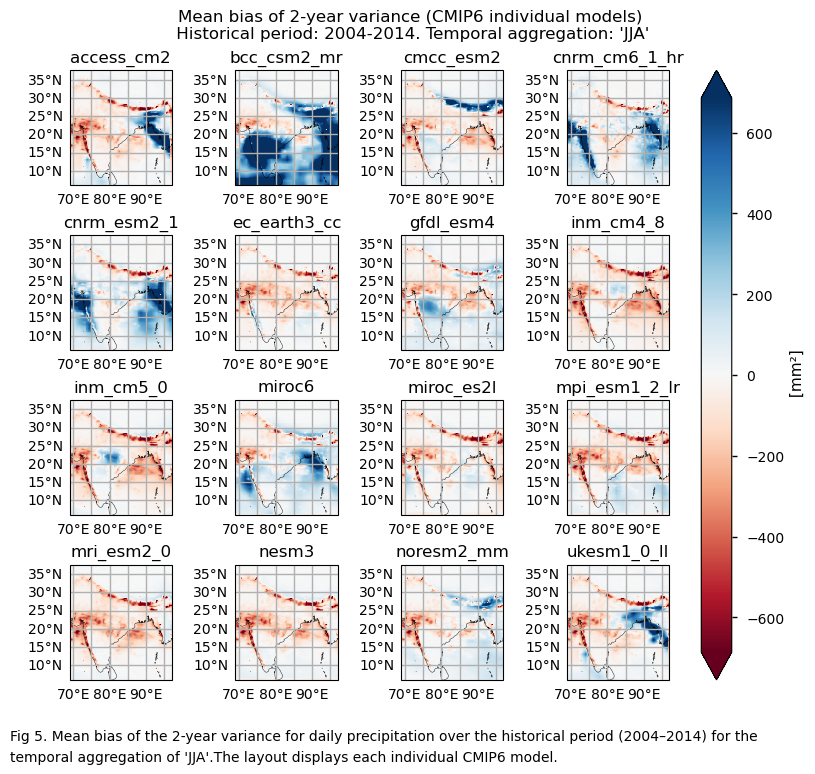
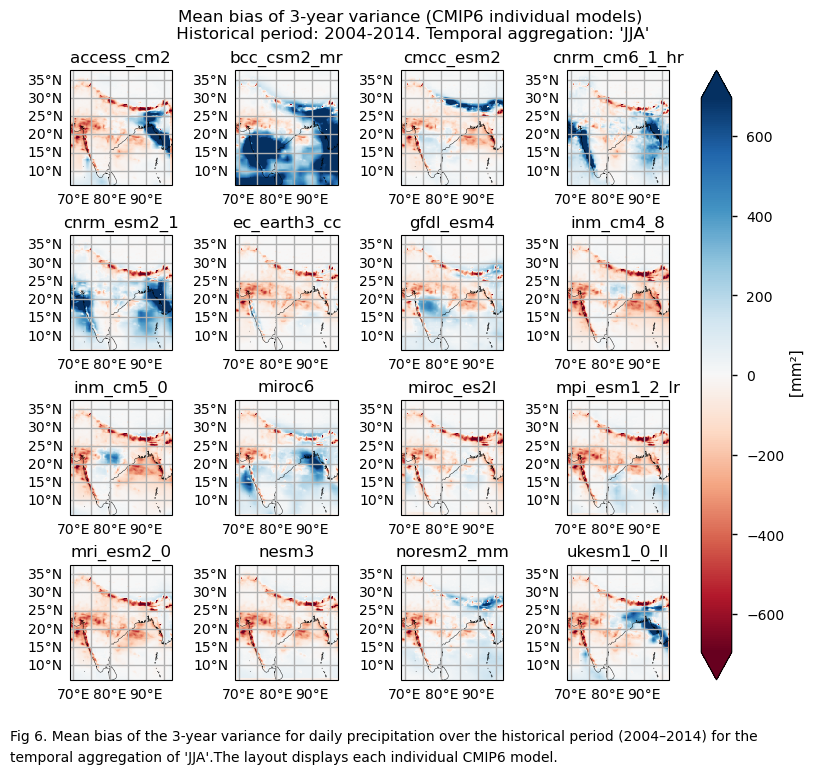
3.5. Timeseries of the variance#
In this last section, we compare the evolution of the 2- and 3-year coefficient of variation spatially averaged for daily precipitation over the period 2004–2014 for the CMIP6 ensemble median and ERA5.
The ensemble spread and the trend of the variances are displayed.
Show code cell source
def plot_trend(time_series, var_values, label, color):
time_numeric = pd.to_numeric(time_series.to_series())
slope, intercept, _, p_value, _ = linregress(time_numeric, var_values)
trend = intercept + slope * time_numeric
slope_per_decade = slope * 10 * (60 * 60 * 24 * 365.25 * 10**9) # nanoseconds to decade
plt.plot(time_series, trend, linestyle='--', color=color, label=label)
return slope_per_decade, p_value
# Define the colors
colors = {"CMIP6": "green", "ERA5": "black"}
# Cutout region
regionalise_kwargs = {
"lon_slice": slice(area[1], area[3]),
"lat_slice": slice(area[0], area[2]),
}
# Get the spatial mean for ERA5
era5_mean = diagnostics.spatial_weighted_mean(utils.regionalise(ds_era5, **regionalise_kwargs))["coefficient_of_variation"]
# Get the spatial mean for CMIP6, preserving each model
cmip6_means = [
diagnostics.spatial_weighted_mean(
utils.regionalise(ds.expand_dims(model=[model]), **regionalise_kwargs)
)["coefficient_of_variation"] for model, ds in model_datasets.items()
]
# Calculate the median, ensemble mean, and standard deviation
cmip6_mean_median = xr.concat(cmip6_means, dim="model").median("model", keep_attrs=True)
cmip6_mean_ens_mean = xr.concat(cmip6_means, dim="model").mean("model", keep_attrs=True)
cmip6_mean_std = xr.concat(cmip6_means, dim="model").std("model", keep_attrs=True)
# Initialize list to store trend information
trend_info = []
index_str = 0
# Plotting for each variance
for variance in era5_mean['variance'].values:
plt.figure(figsize=(10, 5))
# Select the corresponding variance for ERA5 and CMIP6
era5_var = era5_mean.sel(variance=variance)
cmip6_var = cmip6_mean_median.sel(variance=variance)
cmip6_var_ens_mean = cmip6_mean_ens_mean.sel(variance=variance)
# Plot individual model series in grey dashed lines
for model_data in cmip6_means:
model_var = model_data.sel(variance=variance)
# Ensure model_var is reduced to 1D for plotting
model_var_values = model_var.values.flatten() if model_var.ndim > 1 else model_var.values
plt.plot(model_var['time'], model_var_values, linestyle='--', color="grey", alpha=0.3)
# Add a legend entry for individual models
plt.plot([], [], linestyle='--', color='grey', alpha=0.3, label='Individual Models')
# Plot ERA5 and CMIP6 median time series
era5_var.plot(label=f"ERA5", color=colors["ERA5"])
cmip6_var.plot(label=f"CMIP6", color=colors["CMIP6"])
# Plot ensemble spread (standard deviation)
std_values = cmip6_mean_std.sel(variance=variance)
plt.fill_between(
cmip6_var_ens_mean['time'],
cmip6_var_ens_mean.values + std_values,
cmip6_var_ens_mean.values - std_values,
color=colors["CMIP6"], alpha=0.2, label='CMIP6 Spread'
)
# Convert time coordinates to pandas datetime for plotting
time_numeric_era5 = pd.to_numeric(era5_var['time'].to_series())
time_numeric_cmip6 = pd.to_numeric(cmip6_var['time'].to_series())
# Plot trends for ERA5 and CMIP6 Median
slope_era5, p_value_era5 = plot_trend(era5_var['time'][~np.isnan(era5_var.values)],
era5_var.values[~np.isnan(era5_var.values)],
f"ERA5 Trend", colors["ERA5"])
slope_cmip6, p_value_cmip6 = plot_trend(cmip6_var['time'][~np.isnan(cmip6_var.values)],
cmip6_var.values[~np.isnan(cmip6_var.values)],
f"CMIP6 Median Trend", colors["CMIP6"])
# Append trend information, ensuring the index is within bounds
if index_str < len(variance_values):
trend_info.clear()
trend_info.append((f"ERA5 {variance_values[index_str]}-year coefficient of variation", slope_era5, p_value_era5))
trend_info.append((f"CMIP6 Median {variance_values[index_str]}-year coefficient of variation", slope_cmip6, p_value_cmip6))
# Customize plot
plt.xlabel('End year of the moving window')
plt.ylabel('')
plt.title(
f"({chr(ord('`')+index_str+1)}) Coefficient of variation (from daily {cmip6_variable_short}). "
f"Width of the moving window: {variance_values[index_str]}-year. \n"
f"Region: lon [{-area[1]}W, {area[3]}E] x lat [{area[2]}N, {area[0]}N] \n"
f"Period: {year_start}-{year_stop}. Temporal aggregation: {timeseries}"
)
plt.legend()
plt.grid()
# Format the x-axis to show the year
ax = plt.gca()
ax.xaxis.set_major_formatter(mdates.DateFormatter('%Y'))
plt.gcf().autofmt_xdate()
# Add trend information as text outside the plot
plt.gcf().text(0.13, -0.015,
'\n'.join([f"{name} Trend: {trend:.2f} (1/decade), p-value: {p:.2e}"
for name, trend, p in trend_info]),
fontsize=12,
ha='left', va='center',
bbox=dict(boxstyle="square,pad=0.5", edgecolor="black", facecolor="lightgray"))
plt.show()
print("\n")
index_str += 1
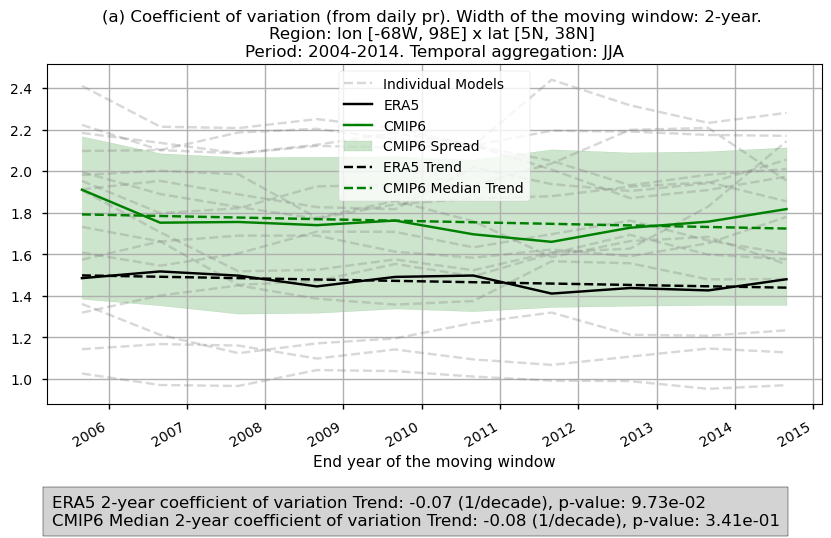

Fig 7. Timeseries of the 2- and 3-year coefficient of variation spatially averaged for daily precipitation over the period 2004–2014 for the CMIP6 ensemble median (green) and ERA5 (black). Dashed lines account for the trend while the shaded area account for the spread of the ensemble. A grey box in the bottom includes the slope of the trend.
3.6. Results summary and discussion#
The spatial patterns of average values for 2- and 3-year variances may reflect influences from orographic features and high-precipitation regions. This impact is removed in the time series analysis, where the coefficient of variation—normalising the standard deviation by the mean—is used.
This approach may reveal distinct orographic effects across the ensemble models, highlighting unique dependencies on orography for precipitation variance in some models.
These patterns may be driven by different dynamic and thermodynamic mechanisms, as seen in the contrasts between models like CMCC and BCC.
It is important to note that the results presented are specific to the 16 models chosen, and users should aim to assess as wide a range of models as possible before making a sub-selection.
ℹ️ If you want to know more#
Key resources#
Some key resources and further reading were linked throughout this assessment.
The CDS catalogue entries for the data used were:
CMIP6 climate projections (Daily - Precipitation): https://cds.climate.copernicus.eu/datasets/projections-cmip6?tab=overview
ERA5 hourly data on single levels from 1940 to present (Total precipitation): https://cds.climate.copernicus.eu/datasets/reanalysis-era5-single-levels?tab=overview
Code libraries used:
C3S EQC custom functions,
c3s_eqc_automatic_quality_control, prepared by BOpen
